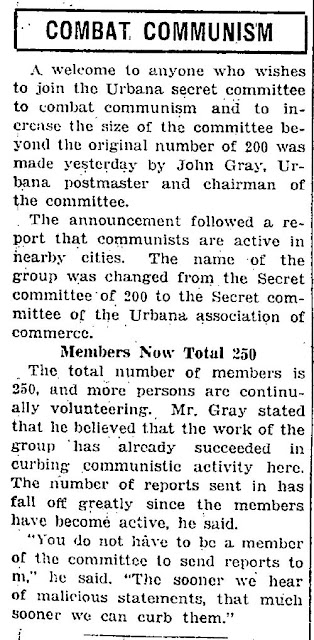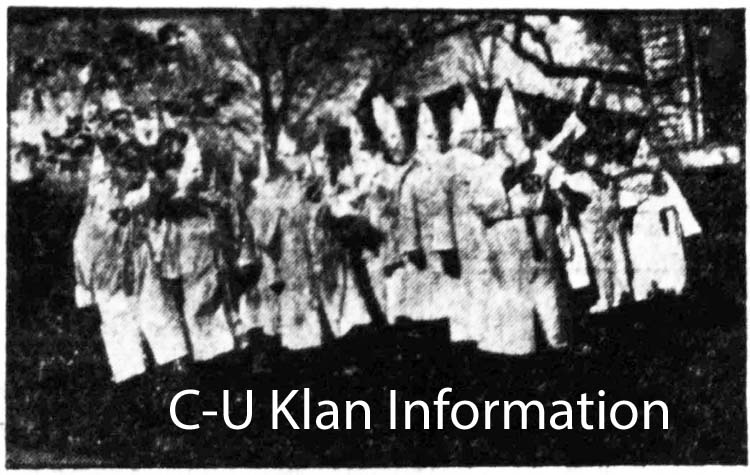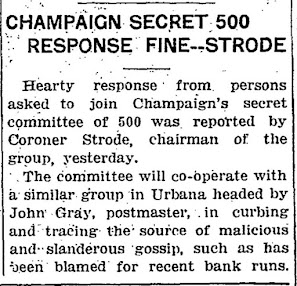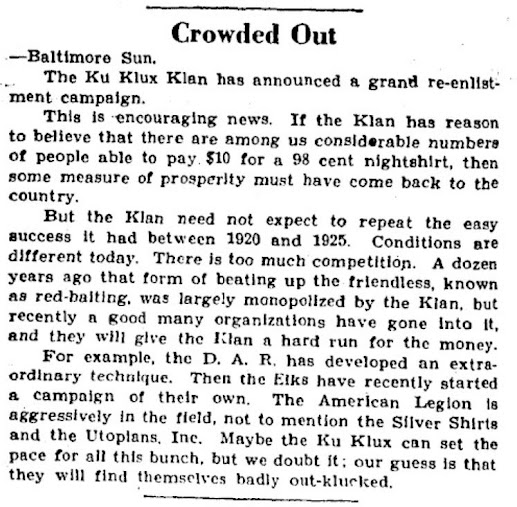 |
| A call for volunteers for a "vigilance committee" against communists and loose talk in the 1/31/1932 Daily Illini. |
As the local Twin Cities Klan organization and its activities faded from public view, the men and women who supported, collaborated with, or were members of the Klan continued on. The 1920s Klan research provides context for some "bookend" events before and after the rise and fall of the public local Klan activity here. The next post will take a prologue look at an attempted lynching in the wake of the 1919 Chicago "race riots" and the other racial pogroms of the Red Summer of 1919. This post looks at epilogue events during the Great Depression's Hoover days. This post also contrasts the efforts to silence even the "whispers" of voices deemed communistic or radical versus openly standing up for the free speech rights of Nazis in the same period of time.
The Great Depression is a fascinating period to look at local history. There were severe economic impacts, real and imagined fears, and extremism. People came together to hold the local community and economy from collapsing, sacrificed, and struggled. One of the famous local responses here was the use of "Urbana Money" as currency in early 1933. It was issued to help keep commerce and the exchange of goods going, with the assurances that it could be exchanged for actual currency later. Examples of a one and five dollar Urbana Money note from the Champaign County Historical Archives:
The Urbana Daily Courier had an article appealing for more volunteers for the "vigilance committee" to hunt communists. From the 1/25/1932 edition:
Champaign had a similar "vigilance committee" organized along the same lines as the one in Urbana. Later we'll also see that the idea was organized across the County as well. From the 2/2/1932 Daily Illini:
The details of the cooperation between the two groups and how much they may have overlapped or served together as an organization for the greater County area is difficult to divine from the public records I've found in the archives so far. The press coverage may have tried to depict as far more collaborative and interwoven than it actually was to aid its efforts.
It is also unclear exactly how much the public committees and personnel of the stabilization plan groups overlapped with the secret vigilance committees. A 2/5/1932 overview of local economic stabilization efforts highlights the variety and collaboration of effort. It also highlights near the bottom, how the "vigilance committee" efforts were spreading across the State and the Midwest:
The then postmaster John Gray was the same former Sheriff John Gray covered in earlier posts here on his public and open support of the Klan during the 1920s, his work and collaboration with notorious Klan raiders such as S. Glenn Young, and even being one of the pallbearers for the "Exalted Cyclops" of the Champaign County Ku Klux Klan years later while serving as Mayor of Urbana. So far I have been unable to determine the affiliation with the Klan (if any) for other leaders listed in this Paxton Record and other local articles.
There was also a "stabilization committee" that appeared to mirror at least some of the organization and goals of the secret vigilance committee in Urbana. Both were organized under the Urbana Association of Commerce. The stabilization committee's public activities were generally reported as more legitimate and lawful canvassing and organizing. An example from the 2/12/1932 Urbana Courier:
Postmaster John Gray was also the head of the recruitment committee for the entire Urbana Association of Commerce (not just its secret vigilance committee) later around this same time according to the 3/15/1932 Courier:
The publicly listed leaders and personnel of the related stabilization and commerce committees include likely Klan members and supporters. Gray and others being intimately aware of Klan members and activities during the previous decade would have almost certainly been aware of their previous affiliations in recruiting and utilizing their services for vigilante work. This included at least one of the three directors under President Webber, Harry A. Little, Klan #1759. It even included other Association of Commerce and local leaders such as Judge Roy Freeman, Klan #356.
The overlap of the Urbana Association of Commerce and known Klan members also included other committee heads and personnel such as Paul W. Freeman, Klan #355; Francis E. Williamson, Klan #1099; John B. Hays, Klan #453; Frank A. Somers, Klan #964; and likely many others. I'm still cross-referencing, confirming, and ruling out duplicate/similar names, ages, timelines, etc.
Coverage of the vigilante work of both the Secret Committee of 300 and other committees included items like this 3/5/1932 Courier article. It notes that John Gray was out of town on a "special mission" dealing with "the activities of radicals and communists in central Illinois." It also highlighted the vigilante work of the "solicitations sanctions committee" and its "campaign to curb out-of-town racketeers."
It's worth noting how much the local press praised this vigilante work, the results it was getting, and how it was inspiring similar measures across the country. From the 2/13 and 2/27/1932 Courier:
This is just a few years after the Courier editorialized on how the real problem with the local Klan here had been its secrecy and the threat of intimidation. This in spite of what it described as its "praiseworthy" goals and unquestionable patriotism. From the 11/20/1928 Courier:
It would also stand in stark contrast to the Courier's 1934 appeal to Communists and other left-wing radicals to stop protesting over Nazi speech. They admonished the far-left to let Nazis speak and to stand up for their free speech rights two years after they happily cheered local vigilance committees cracking down on them. Even just their potential radical whispers:
Indeed, during this time there were Nazis happily spreading their praise of Hitler, his new alternative government concept, and how he was an American ally in the battle against communism. In my local research I stumbled across Rudolf von Wistinghausen, a personal acquaintance with Adolf Hitler, on campus back in 1932. He was giving a pro-Hitler talk to the local Pilgrim Foundation, an organization "to establish for the Congregational students at the University a religious, social and recreational center and to teach the principles of the Christian faith." From the 4/14/1932 Courier:
Turns out this fellow was a grad student at the University at the time and even wrote a series of five front page articles for the DI on Germany. Those culminated in his praise of eugenics, race improvement, and Hitler: "the only man in Germany who was able to fight communism with another and better idea." From his fifth article in the Daily Illini series:
Click to enlarge the snippets to read the full article below:
I found numerous articles of him giving talks in the local community while he was here in the Twin Cities. He would return to Germany within a couple years, join the Nazi party and the Sturmabteilung (SA) in 1934. He survived the war and continued his diplomatic work for the post-war government. In 2006 his Nazi past was part of an exposé in Der Spiegel that caused some controversy for the BdV (an organization for displaced Germans) at the time.
The fervor for the vigilance committee and its goals was evident from the favorable press coverage which included letters from volunteers and gleeful mockery of fearful critics. From the 1/27 and 2/2/1932 Courier:
This fervor culminated in a full blown panic about communists coming to burn down Urbana. The mayor issued "shoot-to-kill" orders to the police and the American Legion volunteered to help hold the line against the coming communist attacks. Headline and article from the 3/17/1932 Courier:
Soon the panic unceremoniously dissipated. From the 3/21/1932 Courier noting the withdrawal of anti-communist guards from the local public schools:
Kacich described the post-panic situation in his book Hot Type:
The period between the first and second Red Scare after first and second World Wars was not much of a lull in the general fears, panic, and accusations over communism and radicalism associated with the term. Yet, the reaction to communist and radical fears was generally not listed among the motivating forces among American and European far-right movements in the local press. From the 7/3/1934 editorial on attempts to revive the Klan and the rise of other fascist groups in the United States in 1934:
No mention of the communism they all hated and opposed so vocally. This, along with ongoing panics, appears to indicate that extremist anti-communism was mainstream. Much like the Klan "aims and aspirations" the Courier argued were "praiseworthy" along with its previous criticisms years earlier. Anti-communist extremism would go on to be a major factor in the rise of later Klan activity and other far-right and white nationalist groups locally.
There can obviously be legitimate criticism and concerns over extremism (such as revolutionary communism or fascism) and the threat it may pose. But this can also easily become the basis for other forms of violent extremism against out-groups deemed an existential threat to the in-group's community. This propensity appears to be far more common than rare, as this research regularly shows.

























































